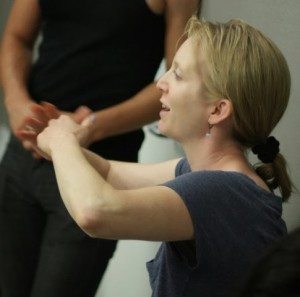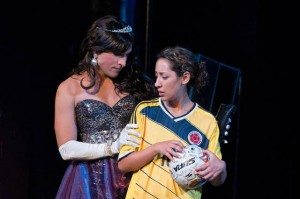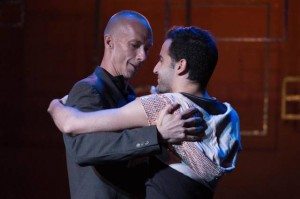
 Everyone knows the story of the three blind men and the elephant. As ablest as it may be (which it is), the metaphor points to one invaluable truth: E Pluribus Unim. Out of many, comes one.
Everyone knows the story of the three blind men and the elephant. As ablest as it may be (which it is), the metaphor points to one invaluable truth: E Pluribus Unim. Out of many, comes one.
In I Like to Be Here: Jackson Heights Revisited, or, This is a Mango, this ideal purveys every detail and aspect of the story. The requisite effect is that there is no central character. Rather, the protagonist is the community, the antagonist is the community, and the solution is the community. In this harrowing glimpse into the interconnections, dependencies and conflicts amongst the people living in a Jackson Heights neighborhood ring is authentic and gripping. From sex workers to new fathers, everyone is connected in the most intricate and vital ways. We sat down with director and creator Ari Laura Kreith to get a deeper look into I Like To Be Here and its remarkable origin.
One of the first things I noticed about I Like To Be Here is that in a play focusing on the many voices of a community, there are multiple playwrights attached to the work. Could you tell us more about what inspired you to approach the project this way?
I became very interested in that and also devising a process that was reflective of the story we were trying to tell, which was really a story of how diverse people and perspectives can come together, and how the process itself reflects the meaning of the work, which is important to me.
Yes, there are certain moments that ring authentic, because there’s specificity in it. There’s not just a glossed over idea of a person, but actual concrete details. How did the writing process operate? Let’s go bit-by-bit – so you had one playwright come in, and then someone else would add to it? Or did they all come into a room and decide upon this story?
Well the first piece, I brought everybody out to Jackson Heights, and there were some people who had never been to the community before. And some people – actually, Les Hunter lived in Jackson Heights, and he was the ‘home base’ playwright. He and Jenny Lyn Bader had been involved in all three of the plays. And Jenny Lyn: I had worked on a number of her plays before, but we had never worked on anything like this.

Gotcha. New Territory?
Very! So the first evening of the first piece, I actually brought the playwrights out into the neighborhood. Before we went out, we had specific leaders come and speak to them, and give them different perspectives. Some of the leaders were involved in Historic Beautification. There was an immigration rights lawyer. So we got an introduction to the neighborhood from varying knowledgeable perspectives, but all of them had their own sort of view on the neighborhood and existing culture.
Then we went out for that day. They sort of walked around for about three hours, individually or in pairs, and then we came back and drew this map. It was on a giant, taped together butcher of paper that covered the entire floor.
And we drew a map of what our experiences had been, and worked to populate it with characters. Each person created a character and put it on the map. There was another assignment to create a character that might interact with that original character and put it on the map, and so on. By the end of the day, each writer had created three characters that might connect with other characters.
Then everyone went home, and populated all of those characters onto a Google Document, so that we could all have access to them when we worked together. And then people started claiming characters who they wanted to write for.
Wow. That’s beautiful.
Yeah! Each playwright created three characters, but then they ended up writing for characters they might not have created but still responded to. And so the goal became to populate this world and tell stories from the people who we created on that first day.
So, the second piece Theatre 167 created [as part of the Jackson Heights trilogy], You Are Now the Owner of This Suitcase, featured a lot of the same characters from 167 Tongues [the first], but was framed through a Magical Realism perspective. What led you guys to make the change in storytelling?
The first piece really contained more discreet stories, in 167 Tongues. Out of that, and out of that process, a kind of way of working was born. So the second time, when people were coming in, I was sort of clear that we were gonna be working together, and that things were gonna be fluid and changing. I grew up in countries outside of the US as a child, where theatre feels very different, and theatre is for all ages - as opposed to here, where sometimes children’s theatre gets very segregated. So when looking at ways of bringing different cultures and communities together, I was always interested in building a piece that might bring adults and children to the theatre together. So the second piece we asked people to tell us about the fairytales they remembered from their childhood, and of course with Jackson Heights we have fairytales from all over the world. That became the emphasis for the second piece, You Are Now the Owner of this Suitcase, which delved into magical realism.
In response to what you asked about how the process evolved, and how the ownership evolved - by the end of You Are Now The Owner of this Suitcase, we had an acting company in the sense of returning artists that we continue to work with.
And so by the third play [Jackson Heights 3AM], we were also very interested that there was this whole other world in Jackson Heights after hours. 10 pm. 4 am. You see a very different side of the neighborhood.

In this one the actors were more involved, and some of the core actors were involved since the very beginning. As they got to go out and have experiences, to find characters who spoke to them and bring them into the room. We were also able to look at particular members of the acting company and say: "We would like to create a role for you that explores 'X.'"
Since our acting company is so diverse and reflected many of the demographics of that neighborhood, we got to explore their truths and stories they hadn't yet been allowed to tell, but also stories from the neighborhood that they hadn’t yet been able to tell.
That brings us to where we are now, with I Like to Be Here.
Yeah! Well we did an entire trilogy over the course of three years, and then we did this crazy thing where we did all three plays in rep – which was a six-hour, 93 character, 35 per each actor, 14 language extravaganza. It was a little insane, but also a glorious experience to have where we found heightened resonances between the three plays. We jokingly referred to it as the ‘Coast of LaGuardia.’
I Like to Be Here: Jackson Heights Revisited, or, This is a Mango continues its run at the New Ohio Theatre through September 27. For more information and tickets, visithttps://www.Theatre167.org